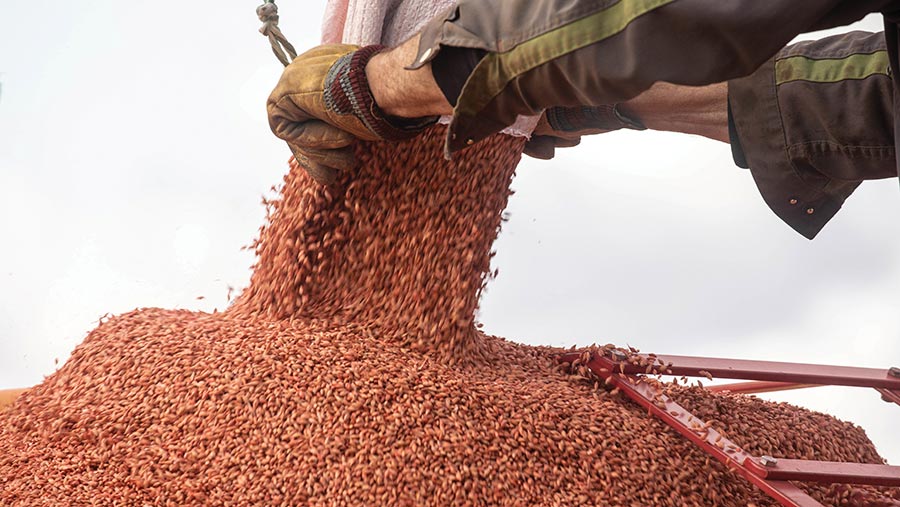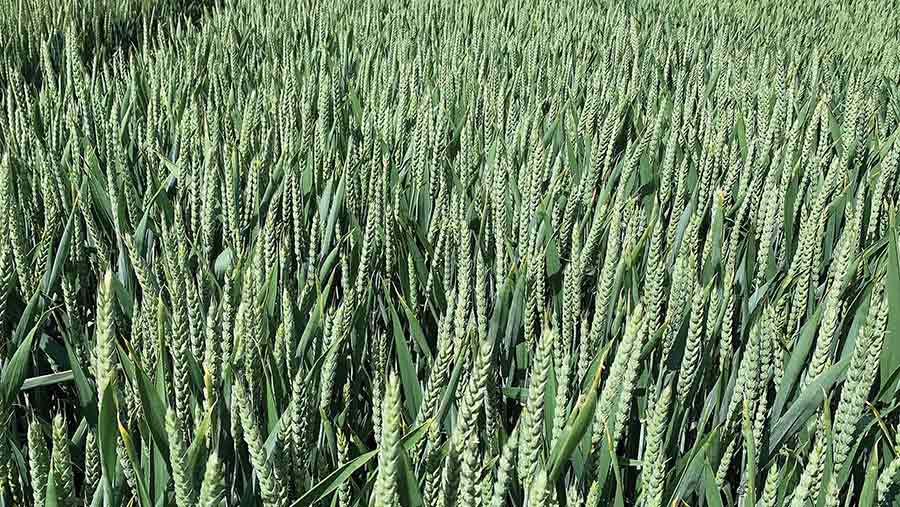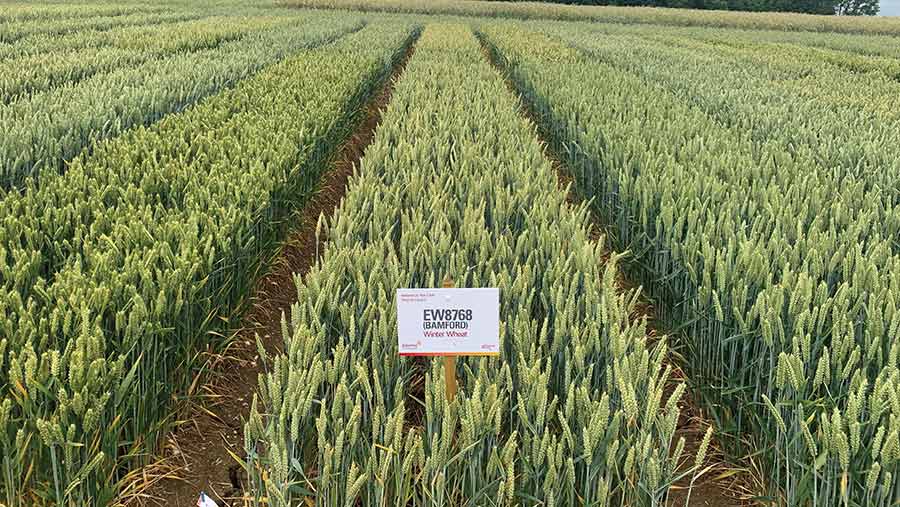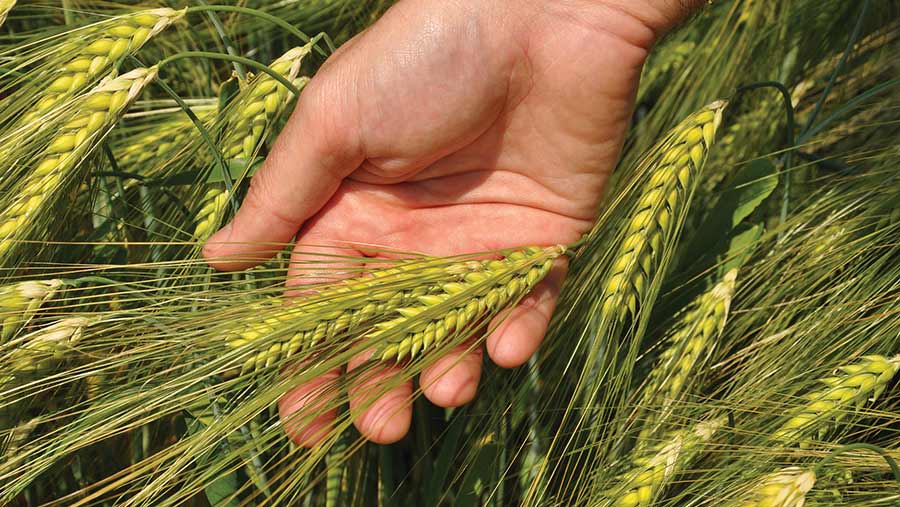New wheat and barley varieties rejuvenate Recommended Lists
 © Tim Scrivener
© Tim Scrivener The latest winter wheat varieties to be added to the AHDB Recommended List for 2024-25 are expected to breathe new life into at least two end-use groups, with most of them tipped to gain market share.
A slimmed-down list contains five new winter wheats, including a long-awaited provisional Group 1 variety and two much-needed soft milling Group 3 debutants – one of which is seen as a game changer.
See also: Wheat blends prove simple way to boost average yields
There are also two new high-yielding Group 4s, one soft and one hard, while 10 varieties have been removed from the list. There were no additions to Group 2.
Group 1 – Cheer
The new provisional Group 1, Cheer from Syngenta, comes onto the list with a yield of 97%, putting it below Zyatt on 99%.
The first new Group 1 since 2017, the newcomer’s better disease resistance is welcomed, especially its yellow rust resistance rating of 7.
As with all new bread-making varieties, Cheer’s Group 1 classification won’t be confirmed by UK Flour Millers until next spring.
“The initial baking quality tests have been good, including gluten strength,” says Recommended List (RL) manager Dr Paul Gosling.
A strong set of disease resistance ratings are reflected in its untreated yield of 84%, which puts clear distance between Cheer and the existing Group 1s, he reports. The only shortfall is that it doesn’t have orange wheat blossom midge resistance.
“Cheer’s addition to the list is a positive development and helps to de-risk this important sector,” says Niab cereals specialist Clare Leaman. “Yellow rust is the limiting factor and this variety has a 7 rating – expanding the choice in an otherwise tired group of varieties.”
Jim Knightbraid, seed business development manager with Frontier Agriculture agrees.
“In our untreated trials, Cheer gave a yield of 9.11t/ha, which shows that it has much more resilience than the existing choices and can plug some of the current gaps.
“Of course, we would all love to see a bit more yield in a new variety, but it does mean that growers will be less reliant on fungicides. It’s a sensible option.”
With the highest grain specific weight of the Group 1s, at 79.5kg/hl, and Hagberg, at 299, a protein of 13% are further features of Cheer.
“That protein content is just below Crusoe, which is the gold standard as far as millers are concerned.”

© Syngenta
Group 3 – Bamford and Almara
The new soft milling Group 3 varieties are Bamford from Elsoms Seeds and Almara from Senova, the latter being recommended for the North.
Both varieties are suitable for multiple outlets, with medium ratings for distilling and suitability for export, as well as the domestic biscuit market.
Bamford is way ahead on yield, with a UK treated figure of 106% and an untreated yield of 92%, says Paul.
“At this level, it matches feed varieties for output. Bamford also has good disease resistance and grain quality, as well as suitability for a range of sowing dates and soil types.”
Jim predicts that Bamford will revitalise the Group 3 sector, which has been in sharp decline over the past few years.
“It’s one of just four varieties on a yield of 106%, its septoria rating of 6.7 is better than that of Dawsum and it also carries the Pch1 gene for eyespot, so it works as a second wheat too.”
A different genetic background means that previous concerns about septoria resistance based on Cougar parentage among Group 3s do not apply to Bamford, clearing the way for it to sell well.
“Bamford could be a game changer,” says Clare. “Anyone farming close to a suitable mill will like the look of it, as will feed wheat growers.”
A good specific weight of 78.5kg/hl and a lodging resistance rating of 7 are also in its favour, as are a yellow rust score of 7 and an eyespot rating of 6.
The only disappointment is a lack of orange wheat blossom midge resistance.
“After some dismal years with Group 3s, you have to ask what’s not to like about Bamford,” she summarises.
The other new Group 3, Almara, is recommended for the north region, where it has a treated yield of 102% and a good untreated yield of 87%.
A yellow rust resistance rating of 8 is complemented by 6 ratings for septoria, brown rust and mildew, as well as resistance to orange wheat blossom midge.
Slightly earlier to mature than many existing Group 3 varieties, which is a key requirement for the North, Almara has a lodging resistance rating of 7.
“Almara adds to the choice for growers in the North, where it meets the needs of distillers,” says Clare.

© MAG/David Jones
Group 4 – Blackstone (soft) and Beowulf (hard)
The only new soft Group 4 winter wheat is Blackstone, also from Elsoms Seeds.
Another to receive a medium rating for distilling, Blackstone has a better specific weight of 78.2kg/hl than other soft feed wheats.
“Blackstone is an interesting variety as it has a very wide drilling window, from September through to February,” reveals Jim.
“After the autumn that we’ve just had, that’s going to be seen as a bonus.”
Good marketing options and orange wheat blossom midge resistance add to its appeal, he believes.
“It’s slightly off the highest yielders on 103%, compared with Redwald on 106%, but it has the best grain quality of any soft types and offers some reassurance on sprouting too.”
The final newcomer is the hard Group 4 Beowulf, which heads the hard Group 4s with a yield of 106%.
Paul notes that Beowulf adds to an already strong hard feed line-up, bringing consistent high yields across regions, resistance to lodging and good grain quality.
“It has an untreated yield of 91%, matching Dawsum, a yellow rust rating of 9 and an eyespot rating of 6. It also has orange wheat blossom midge resistance.”
Jim reports that there is already demand for Beowulf from growers. “It seems to do everything well and I can see this variety being around and popular for some time.”
Very stiff straw and a wide drilling window mean it will be a good partner variety with some of the other high-performing feed types, he adds.
“It has a septoria rating of 6.7 and was a top yielder in Frontier trials.”
Clare’s verdict is that Beowulf is an obvious addition and she can see it being grown in a range of situations.
“A very useful variety, it’s slightly later to mature than some, but there will be lots of interest in it.”
Barley
Winter barley
Two new winter barleys have been recommended this year, including the first barley yellow dwarf virus (BYDV)-tolerant six-row hybrid from Syngenta.
Buzzard is lower yielding than other hybrids, on a UK yield of 103%, but just ahead of the conventional BYDV-tolerant variety Feeris.
With 6 ratings for mildew, brown rust and rhynchosporium, it scores 7 for net blotch and lodging resistance.
“Given the advent of the Sustainable Farming Incentive zero-insecticide payment and the current economic climate, it’s an interesting variety,” says Recommended List (RL) manager Dr Paul Gosling.
Capitol, a conventional two-row feed variety, comes onto the list with a high yield of 106%.
A sister variety to stablemate Caravelle, which was recommended last year, Capitol has given its highest yields in the East, has a good specific weight of 69.9kg/hl and is early maturing.
“It’s really good to see two-rows challenging the hybrids,” says Niab cereals specialist Clare Leaman. “There aren’t any concerns or trade-offs with this one – it’s been very consistent.”

© Syngenta
Spring barley
Six newly recommended high-yielding spring barley varieties – three for brewing only, two for brewing and malt distilling and one for malt distilling only – have been put in the “under test for malting” section and will now go into the MBC testing system.
Until more is known about their suitability for these end uses, growers are advised to wait.
“Maltsters seem less interested in single-use varieties now,” reveals Paul. “There’s a definite steer towards the dual-purpose choices.”
Of the brewing only choices, Bounty from Agrovista is ahead on yield on 105%, but its place on the RL is conditional on it being added to the GB and NI Variety Lists in January 2024.
The other potential brewing newcomers are Gambit from Senova and Aquarius from Limagrain, both of which have a yield of 103%, along with good disease resistance and lodging scores.
New dual-purpose varieties are Belter from Agrii and Olsen from Limagrain, which take yields on compared with the industry standards and have given their best results in the East.
Munro from Senova is for malt distilling only and has given its highest yields in the North.
“Have these varieties on your radar and wait for further news,” suggests Clare. “We do see some of them disappear after a year.”
Recommended List highlights
- Fewer varieties recommended – 23 added and 36 removed
- First Group 1 winter wheat since 2017
- Very high-yielding Group 3 variety with potential to invigorate market sector
- First six-row hybrid barley with barley yellow dwarf virus tolerance
- Incremental improvements in OSR varieties
- New list layout for clarity
Winter wheat Recommended List additions |
|
|
Variety |
Fungicide-treated yield (%) |
|
Group 1 milling wheats |
|
| Cheer (Syngenta) | 97 |
|
Group 3 biscuit-making wheats |
|
| Bamford (Elsoms) | 106 |
| Almara (Senova) | 102 (North) |
|
Group 4 soft feed wheats |
|
| Blackstone (Elsoms) | 103 |
|
Group 4 hard feed wheats |
|
| Beowulf (Limagrain) | 106 |
Winter barley Recommended List additions |
|
|
Variety |
Fungicide-treated yield (%) |
|
Two-row feed varieties |
|
| Capitol (Limagrain) | 106 |
|
Six-row feed varieties |
|
| Buzzard (Syngenta) | 103 |
Spring barley Recommended List additions |
|
|
Variety |
Fungicide-treated yield (%) |
|
Malting varieties |
|
| Bounty (Agrovista) | 105 |
| Gambit (Senova) | 103 |
| Belter (Secobra) | 103 |
| Munro (Senova) | 103 |
| Aquarius (Limagrain) | 103 |
| Olsen (Sejet) | 102 |

